
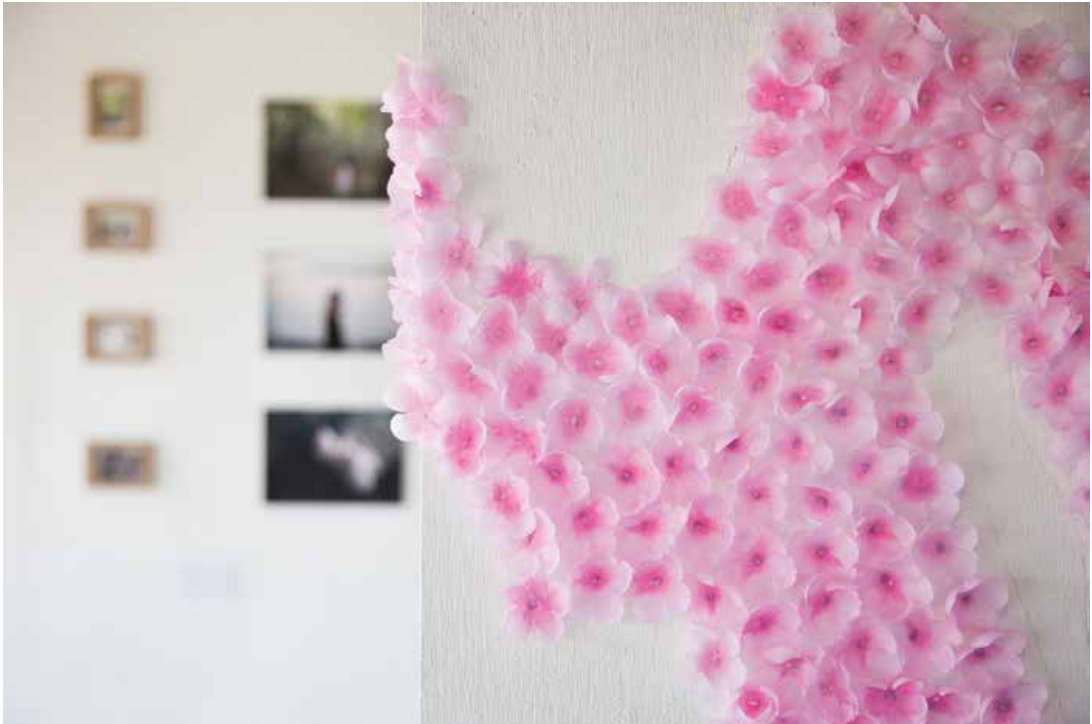

Tribute / Installation view at Studio Kura / Fukuoka, Japan, 2016
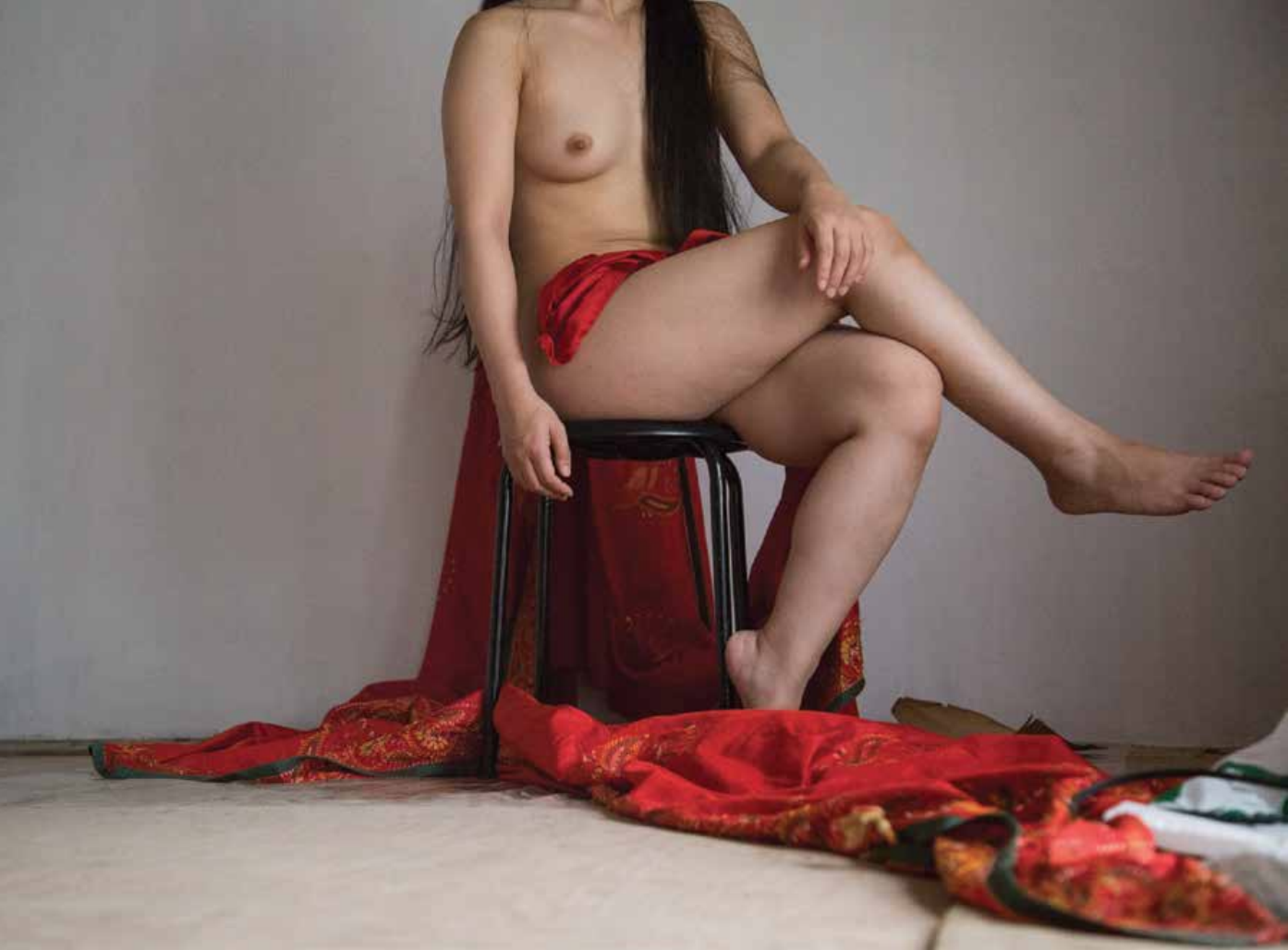
Ayami / C. Print / Studio Kura, Fukuoka, Japan, 2016
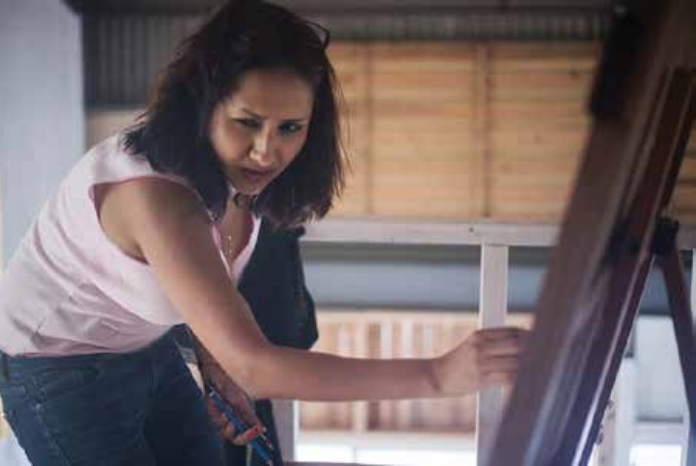
Nazia Andaleeb Preema / at Studio Kura, Fukuoka, Japan, / 2016

Opposite / Found Objects / Collage / Fukuoka, Japan, 2016
“My entire hand glowed in the dark. The light was actually within me. I started connecting with the glow and it starts dancing with me. It gave me enormous power to feel the rhythm around me. Now I am convinced even darkness contain light.”
– Nazia Andaleeb Preema
Nazia Andaleeb Preema
‘Wabisabi’ refers to a way of living that focuses on finding beauty within the inadequacies of life and serenely accepting the natural cycle of growth and decay. Sensation of Japanese culture, its tradition and their immense natural humbleness towards life and art brings a greater phenomenon to a casing crowd of desirability.
In Studio Kura, we had two houses to stay. Me and my fellow roommates Charlotte Clermont who is a talented video artist and an awesome photographer Inker Jantti shared one house, including Cathy Laudenbach (Australia), Thomas Hoeren (Germany), Anne-Sophie Guillet (France) all visual artists and one KatsuraIshikawa were my other family for a month as my creative soul mates. I can still feel their subtle voice and untold affection, collaboration around me.
This residency, the Japanese would say, is ‘Kintsukuroi’: the art of repairing a broken pottery with gold or silver and that the piece becomes additionally valuable and sturdier for being broken after a rebirth. After the tragic incident at Holey Artisan, in July 2016, I have witnessed that my city was literally broken and it shook me from my core. I desired to be touched by the gratifying absence of distress which emphasizes on simplicity of contentment.
Ikisan is one of the places in Itoshima, far away from the cities; it takes 25 stations from the Fukuoka city, under Kyushu Prefecture. I wanted to be immersed in nature, as the Japanese believe, to let the self be touched by every marvels. Studio Kura was in a rural area close to rice fields and the sea which I felt were exactly the rudiments I needed to reconnect with. Drowned in countryside, walking for two hours, I could heal myself from the illness of urban bedlam.
Observing green for all the time and the changes of colors at day and night, I was able to taste the smell of the heat, cold and silence, as well as watch each little difference appearing from the breeze on a leaf or on the surface of water, illumination of the energy of its culture.
Be passionate about everything that passes by that deep rush leading to manifest life all over again. While walking, the connection between being and nature is a mysterious relationship. I felt grateful to be an artist. I knew this will lift my spirit up to explore my art at an unknown path to surprise myself. I closely observed all the attitude, elements and objects those passed by and made the most out of it with boundless curiosity. I intensely believe it is important as an artist to embrace and sense every feature of the existence around me – still, moving, silent and what not. It was in one word, ‘Sugoi’ – awesome!
Life is 10% of what happens to us and 90 percent how we react to it. Thus, art enables artists to visualize the extensive form of reaction which ought to be fully involved with environment, society, people and surroundings. For me this isolated Ikisan village of Japan was extremely engaging as the other artists in this residency were into photographs, video or sight specific art. In the inaudible nature of the village, each of us was engaged in deeper aesthetics of passionate journey. For me, it was always an inner search of belongings of the place and inspiring my soul to soak into the power of nature that allowed us to vision the unknown.
Since the environment was new to me, I was exhilarated to feel the surrounding with a delusional state of mind. I was a constant observer. Every morning I heard a melody coming from somewhere to encourage and encounter my soul. It was not the perfect time of ‘Sakura’ Cheery blossom but that’s why I missed their white and pink beauty in nature. The depression inspired me to create imaginary Kimono by artificial fabric and it was at the display in the exhibition of the residency program. Japanese cuisine was a perfect blend to entangle with the culture. The raw fish, live squid, various types of Soba, udon and noodles were the core ingredients to understand a food habit which truly inspired me to understand a simple and pure yet very artistic delicacy.
Every ingredient of their food items got a meaning. And I felt ‘Itadakimasu’ meaning ‘I will have this’. It is used before eating any food to express appreciation and respect for life, nature, the person who prepared the food, the person who served the food, and everything else that is related to eating.
It was ‘Ukiyo’ for me, as I was in ‘the floating world’ – living in the moment detached from the bothers of life. I was watching Charlotte, the video artist from Quebec, continuously researching on her old television, tape recorder, sound and unknown fonts in collaboration with visual collages; and I was busy transforming my usable objects into art. I used soba, bamboo leaves, fish and gold papers to mark my experimental art in my residency. I was planning to have an integrated exhibition to showcase my experience.
To create a dialogue through painting and performance with a young Japanese woman named Ayami, I collaborated upon her warm body surface, when Inkeri Jantti was focusing on the frame. I wanted my soul to be free to react to any kind of emotional and visual symbols. Inkeri Jantti took Ayami to the woods and beach to explore her inner spirit by the breeze of ocean and spark of the nature. It inspired me a lot. I took my camera and through the canal of Fukuoka city near Tenjin and Hakata to capture my ‘Hotaru’, a ‘Firefly’ series.
Japan at night is surrounded by lights reflecting on the canal creating a magical yet mysterious atmosphere. It drew me into a world of illumination; with my camera and my curious mind I walked miles after miles. When I close my eyes I still can feel the silence of nature and all those lights that come through the leaves, ‘Komorebi’. I believe a complete artist is able to bathe in the forest, to encounter with no-fear. An artist always wants to be at the end of the world, to meet the new, strange and absurd who can stir artistic ability.
My intention was to challenge my own style and media of work. I enjoy the process of evolution. So the isolation at the residency allows me to deal with interesting symbols, motifs and identities of Japanese culture and environment. I accepted the fact that I am pretty resilient to those weird bugs, cockroaches and spiders around me.
I met several local artists of Itoshima, Fukuoka. Mainly they are pottery artists. In Japan, pottery is a huge aesthetic craft; and their dedication and belief in their craft really made me humble. “Simplicity can be so attractive and being humble can be so precious”, I learned once again. I observed local Japanese women, they are free, confident and inspiring. Each morning we greeted each other with a beautiful word, ‘Konichiwa’ or Hello!
Shrines, interesting looking religious structures were a major part of Japan. The place is so serene that I never felt the presence of anyone else. That is because in their deepest silence, no one knows they are chanting around in the Shrine. At night, the sky looked like dark indigo. Stars were gazing at us. I remember sometime when I was coming back from the city by the last train at 11 pm, I used to walk through the paddy field in complete darkness. I never felt alone. The gentle breeze was giving me a company, the golden moon walked all the way with me. At times, I could not stop my tears from falling. I could not believe that I am at that situation and place where I am completely free to feel anything that comes to my mind and to think without fear. I was actually living my mind, spirit and soul. It increased my ability to create on my surface with freedom. So, my watercolor on Japanese handmade paper was allowing me to float on a fluid direction of abundance of nature. It is amazing to realize how an environment can effect one’s artistic process.
Art makes me sense the bloom around and within. I need to find a place to free my inner inhibition, an environment that would allow me to break any rule at any point. In Fukuoka, I was a learner, it was discovering the unknown like a child, learning things that were not new but never learned. Like using a chopstick, holding a cup full of green tea, not to bother other people’s freedom, talking sensibly and making sense, observing details that are happening around and certainly appreciating nature.
All artists in the residency were enjoying the process very much; therefore, we were sharing our understanding. It helps us to critique each other in the most constructive way. Our goal was to make an exhibition of our experience at the end.
In my exhibition at the end of the residency program was entitled ‘From Japan with Love’. Because, my tribute to Japan will not be enough if I don’t tribute my love to them. It was a mixed media exhibition, I put up the exotic-aesthetic expressions of Ayami’s sensual body, imaginary kimono with artificial pink cherries, black roses made out of fabric were installed with tampons soaked in puberty red hue, a real unknown fish, the ‘Hotaru’ series of photographs, photo manipulation on watercolor. But most importantly I wanted to do a performance with a Japanese girl to show my intense emotional tribute to their culture because on 1 July 2016, the Japanese, three Bangladeshis, one Indian and nine Italians were brutally killed in my country. I was terribly shocked and felt terribly guilty as an artist.
It was a performance for me to understand and realize the freedom of spirit. Through touching each other we desperately wanted to touch our souls. Women are symbol of humanity and we were deeply trying to connect through each and every part of our body. It was an improvisation and self-modulation as well. We slowly entered the audience and started to touch them as well. It was shocking at first for the audience but slowly as the performance reached it enhanced the energy that was spread among the people who were witnessing the ‘intimate skirmish’.
I tried to make people react to my act of love and violence to bring them out from their inner secure self. Because I believe each individual standing and watching the performance would somehow connect. For me it was important to bring them out from their comfort zone, as if they can’t do it, we can’t break free from this claustrophobic, uncomfortable situation. And for me, I again test my tolerance and limit to liberate myself as an artist.
Each step of my performance was digging myself out there and opened me up to touch every individual. Touch is a very prevailing tool to connect and to communicate. Therefore, I was there to search myself again to take myself to the next level.
Arigatouguzaimasu to Nippon and ‘Sayonara’ till we meet again! Last but not the least, I would just like to say that this journey just made me feel that I’m on the pursuit of happiness!

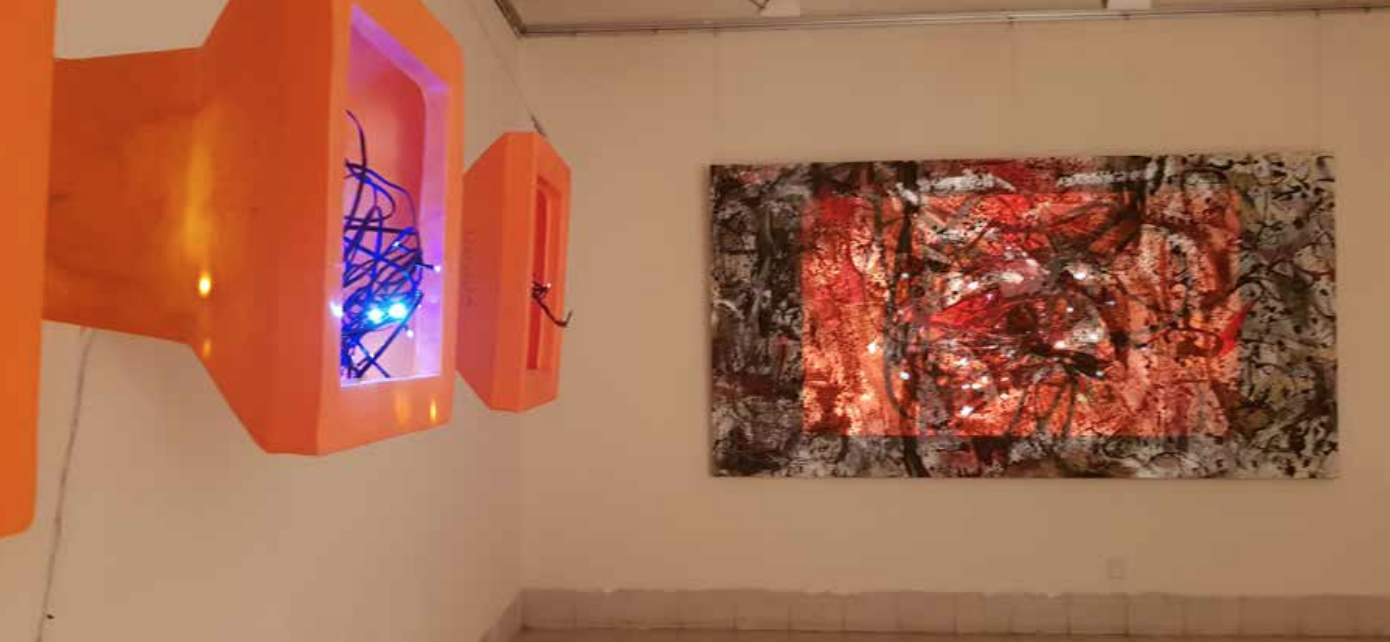
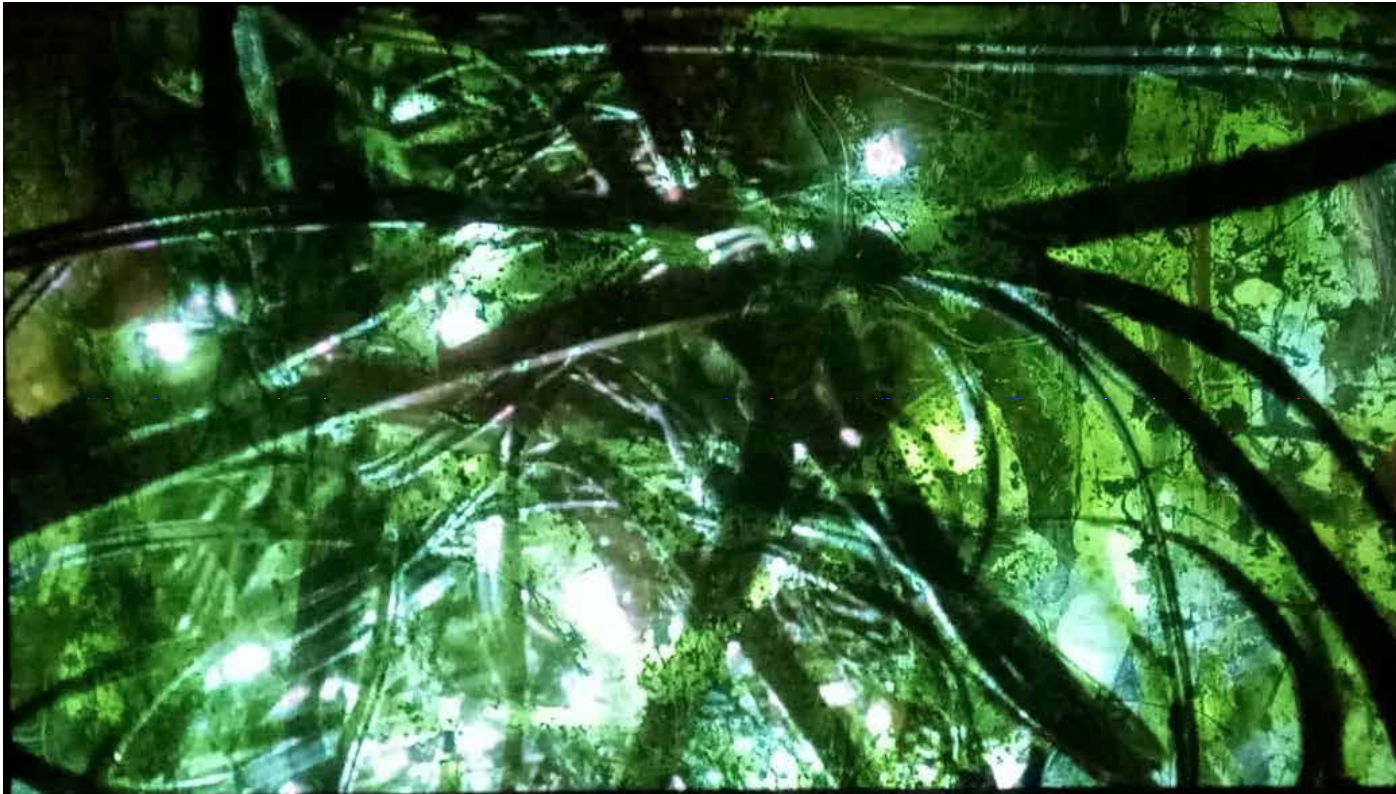
Preema’s De STIJL embraces abstract visual elements such as geometric forms and primary colors (Red, Blue and Green), where the vacuum is reflected by the prominence of blackness in the setting of the gallery. It also suggests a disruption and intervention. Moreover, the video installation of wires, painting, and the 3 primary colours along with the emptiness in the gallery—all together form an art that not only connects the viewers with a context, but also makes the viewers indulge into aestheticism: as if a spiritualized world order. Connecting with the past—the artistic movement, Preema’s installation artwork De STIJL (the style) opens a new vision of aesthetics, of spirituality.

